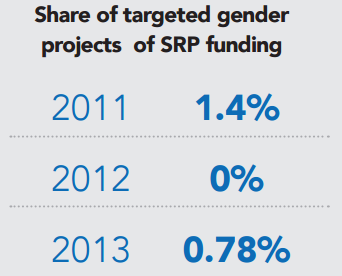Gender focus in the oPt 2015 humanitarian response
Two projects to provide services to GBV survivors in Gaza
Of the 216 projects in the 2015 Strategic Response Plan (SRP), only eight projects specify gender equality as a principal purpose of the project (i.e. having a 2b Gender Marker Code). The total requested budget for those eight projects is US$ 2,417,335 - representing 0.34 per cent of the total requested budget. Seven of the eight projects focus on Gaza and one project focuses on Area C of the West Bank. Five projects focus on Gender Based Violence (GBV) interventions; two projects focus on food security and livelihood needs related to women with disabilities and rural women; and one project is related to coordination.
During the first half of 2015, two of the eight projects received funding for a total of US$ 679,298, providing 28 per cent funding coverage for projects with a 2b Gender Marker Code. The funded projects focus on provision of GBV-related services in Gaza.
The oPt has been applying the Inter-Agency Standing Committee (IASC) Gender Marker coding to SRP projects since 2011. Two performance indicators were included in the 2014 and 2015 SRPs. The set targets are that:
- 75 per cent of the number of funded projects are gender focused; namely, projects that demonstrate evidence that they will significantly contribute to gender equality, according to the set criteria for 2a Gender Marker coding and the projects with targeted action on gender equality (2b).
- 2 per cent of total funded projects are allocated to projects with targeted action on gender equality coded 2B.

On the second target, data show that only 0.2 per cent of the total funding received is dedicated to projects prioritizing gender equality. When comparing this figure to previous years, it is evident that with the exception of 2011, the use of targeted programming to address gender vulnerabilities has been very low (1.40 per cent in 2011; 0 per cent in 2012; 0.78 per cent in 2013; with a cumulative average of 0.72 per cent for of the total SRP funding for those three years).
UN Women and OCHA are closely working with women's organizations, AIDA members, UN agencies and donors to address the gaps in programming and funding. OCHA is also working with information management specialists in the humanitarian team to make available refined data and analysis on gender differentiated needs, emphasizing the value of sex disaggregated data in reporting on direct beneficiaries of humanitarian assistance. These efforts strive to increase the visibility of the gendered impact of the humanitarian situation on the population and increase the understanding of the value of gender-targeted humanitarian programming for ensuring assistance to groups that often fall through the cracks. Gender targeted programming also allows for tailoring vital assistance to particular groups whose needs cannot be met through a mainstreaming approach.
* This piece was provided by by UN Women.









